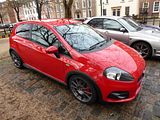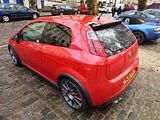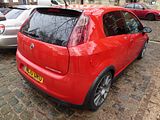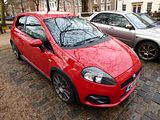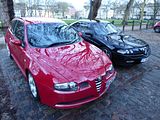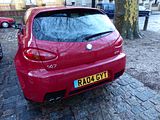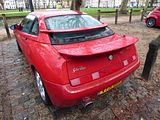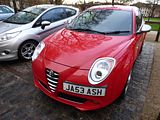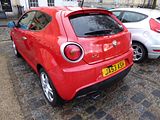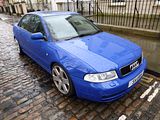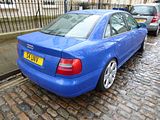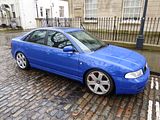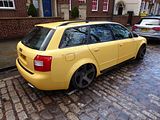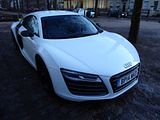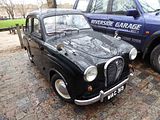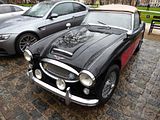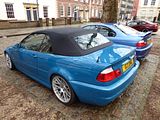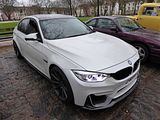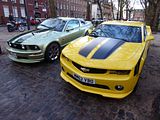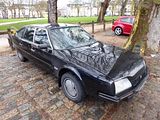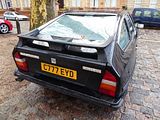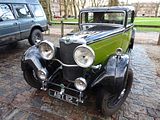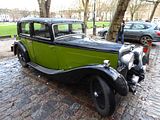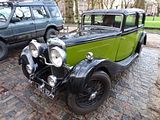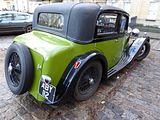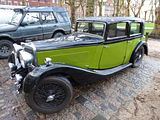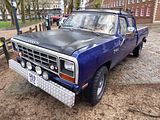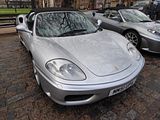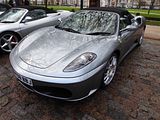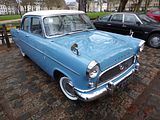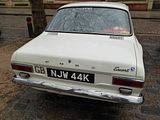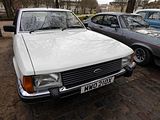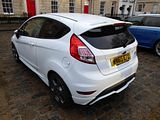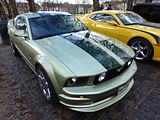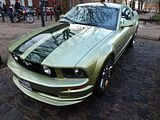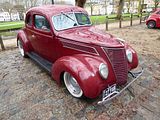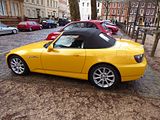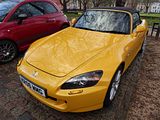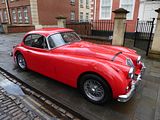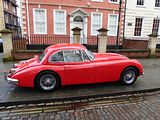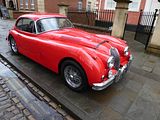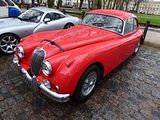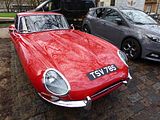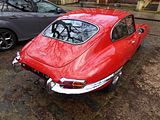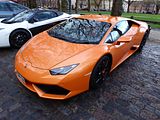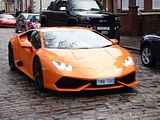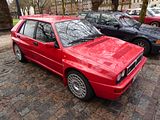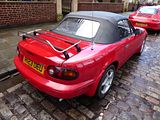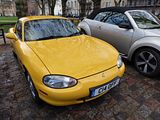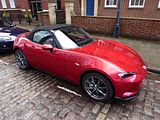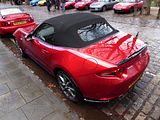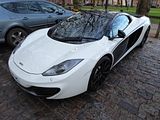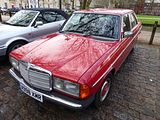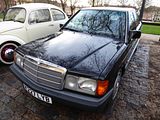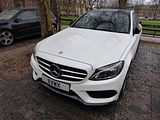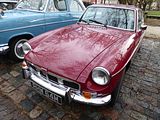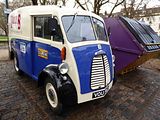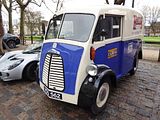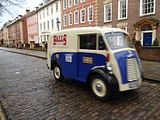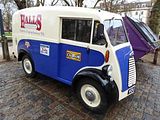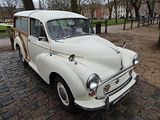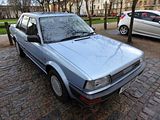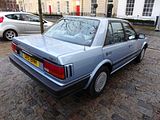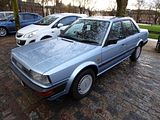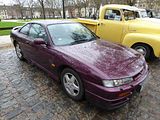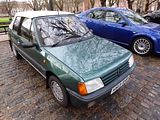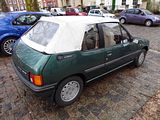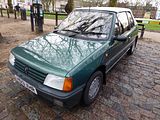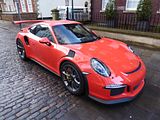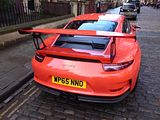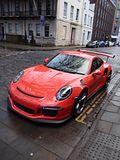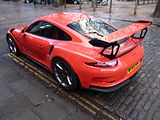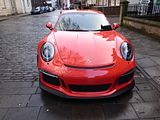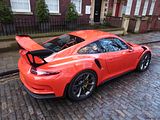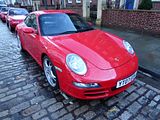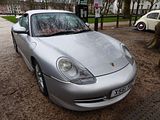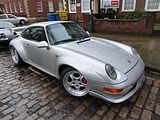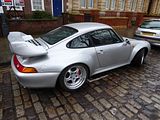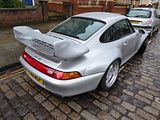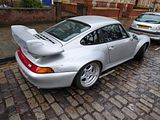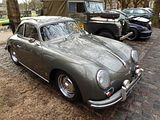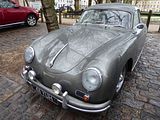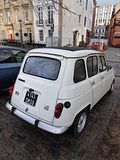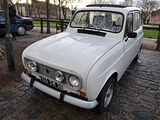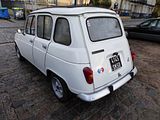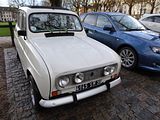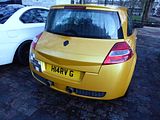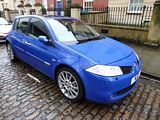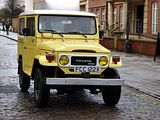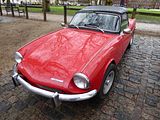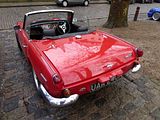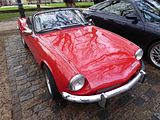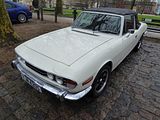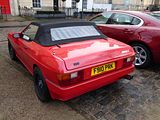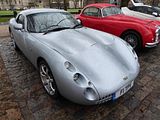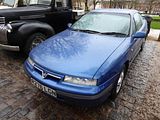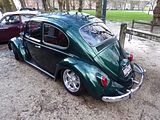Popular stereotype would have everyone believe that all the British talk about is the weather. Whilst I don’t think that is entirely true, it is definitely the case that because we live in a part of the world where our climate is both very variable and somewhat unpredictable, it does have a bearing on some of our plans. And so, when looking at a January rather devoid of car events, although the January Queen Square Breakfast Club meeting was an obvious choice for something to get me out of the house and with a bunch of fellow enthusiasts, as I surveyed the forecasts for the second weekend of the month, it seemed that heavy rain was likely. Whilst I don’t mind getting wet (sometimes!), I know that this can be a major deterrent for others, and hence I did wonder if the January event would amount to much. One advantage of something like a Breakfast meet, with no tickets required, is that you can make a real time decision on the day. When I looked out of the window at around 7:30am, it was still dark, but equally clearly, it was not actually raining, and the updated forecast suggested that it should stay dry, if exceedingly overcast until mid-morning. Time enough to pop down to the Square, and if it was empty, to come back home again. Although many were doubtless put off by the prospect of rain, or even the reality of it only a few miles away, as I was later to learn, enough others adopted the same approach as me, so there was plenty to see until around 10:30am when the skies did start to drop wet on us, which was the cue for a lot of attendees to head back home. After the unwelcome appearance of no fewer than four parking wardens at the event in December, there was no sign of them on this occasion, but even if there had been, there was just about enough space for everyone to park out of their jurisdiction. Maybe getting word around was all the needed to do for now? Anyway, onto the cars, which as ever were a mix of regulars and some vehicles not seen before.
ABARTH
As well as my own 595 Competizione, there was another Abarth here, and just for a change, it was not another 500-based model, but rather it was Edd Cole’s Grande Punto Essesse, There are not many of these cars around, as Abarth only sold around 370 Grande Punto Abarths, and a few of those are no longer with us, and red is definitely one of the rarer colour choices, as most of them were white or black.
AIXAM
Not, perhaps, the sort of car you expect to see here, but proof that “anything goes” really does apply to the event, so this little Aixam was tucked into a small parking area along with a lot of much larger machinery. This is a French company founded in 1983, based in Aix-les-Bains, which makes microcars, or voiturettes, the sort of small wheel devices that can be legally driven without a full driving licence, and which still have a surprising appeal especially in France, where there are a number of producers of such cars. A wide variety of different body styles have been offered over the years, and there have been petrol, diesel and electric engines used to power these cars. Top speed is limited to 45 km/h, though it is possible to have this “unlocked” allowing the brave to get up to 93 km/h! The irony here is that this little car, the smallest at the event, was used to provide a jump start to the largest vehicle here, a Dodge Ram Pickup.
ALFA ROMEO
There was a nice example of the 147 GTA here. The GTA version was launched in 2002, and with its 3.2 V6 engine which produced 247 bhp, it was the most powerful hot hatch available. Performance figures were impressive, with the car able to achieve a top speed of 153 mph. It had a widened body by 15 mm at each side to accommodate the 225/45R17 tyres. Most models had a 6-speed manual transmissions; whilst a smaller number of other models used the semi automatic Selespeed system. Production ran through to 2004 and in total 5,029 147 GTAs were built, 1004 of which were Selespeeds.
Also present were a couple of 916 Series GTV cars, an example of the first facelift applied to the car and a later limited edition GTV Cup
Final Alfa here was a MiTo.
AUDI
There was a nice progression of S4 Audi models here. Oldest was the B5 generation, the first off the genre, and there were also, in Avant guise, a B6 and the very recently superceded B8. The B5 model, a 2,7 litre Twin Turbo car had a special appeal to me, as I owned one of these, in the same Nogaro Blue colour from mid 2003 to March 2005. It was my first Audi, and the fastest car I had ever owned at the time. A colleague bought it and kept it for several years, taking it to the office, on holiday and on the track. With over 160,000 miles on the clock, he retired it as a fun weekend car, and then one evening on a stormy night, a tree crashed onto the roof buckling it, making the car a write off. A sad end to a car which was launched as a rival to the M3, with the benefit of Quattro all wheel drive and (to some!) the fact that it was not a BMW! It was replaced by Audi with the B6 model, which looked not a lot different – as has been Audi’s path of gradual evolution in recent years – but with the twin turbos replaced by a thunderous V8 engine under the bonnet. I had the facelifted B7 version of this car for 3 years and it was a fabulous machine as well. By the time the B8 came along. CO2 emissions had become something of a challenge and Audi were forced to revert to a V6, this time with a supercharger bolted on, to give similar output at 333 bhp, but not quite the same sound track. I am of course familiar with a close relative of this car, as mechanically it is identical to my S5 Sportback.
A very early arrival – hence the rather eery lighting effect on the photo – was this R8 V10. It may be nearly 9 years since Audi launched their everyday supercar, but it still stops people in its tracks. This one was parked up by the mobile coffee stall and almost everyone queuing up for the early morning caffeine felt the need to go take a closer look.
AUSTIN
Reminding us just how small cars used to be, was this A35 Saloon. An evolution of the A30 which was launched in 1952, as The Austin’s rival to what would a few weeks later turn out to be an in-house stable-mate following the merger of Austin and Morris, this model stayed in production until 1959 when it was replaced by the Mini. The Morris Minor was already well established when rival Austin launched their competitor, the A30 Saloon of 1952. That was also the year that Austin and Morris merged to become the British Motor Corporation, so suddenly the two cars that had been conceived to compete against each other were stablemates. Except BMC did not work like that. Separate dealer chains remained in place, as they would do for a further 30 years, and whilst this may sound inefficient now, it has to be noted that brand loyalty was such that there were plenty of people would only consider an Austin say, and not a Morris, or vice versa. The A30 was smaller than the Minor and at £507, at launch, it was also £60 cheaper. The body structure was designed by T.K. Garrett, who had been an aeronautical engineer before joining Austin. It was of fully stressed monocoque chassis-less construction, which made it lighter and stiffer than most contemporary vehicles, the first Austin to be made in this way. Inside there were individual seats at the front and a bench at the rear covered in PVC with an option of leather facings on the seats. Evidence of economy was seen in only having a single windscreen wiper, central combined stop/tail/numberplate lamp and a sun visor in front of the driver only. A passenger-side wiper and sun visor, and a heater were available as optional extras. Even so, it sold well, and 223,264 examples were built. The A30 was replaced by the Austin A35 in 1956 with the new name reflecting the larger and more powerful 34 hp A-Series engine, which gave the car a slightly higher top speed and better acceleration, though much of this came as a result of different gearbox ratios. The A30 had the first three ratios close together then a big gap to top, whereas in the A35, the ratios were better spaced and gave a higher speed in third gear. That top speed was 72 mph and 0 – 60 acceleration times are just over 30 seconds, so this remains a very slow car by modern standards. The A35 was very similar in appearance to the A30, and is best recognised by its larger rear window aperture and a painted front grille, with chrome horse-shoe surround, instead of the chrome grille featured on the A30. The semaphore trafficators were replaced with present-day front- and rear-mounted flashing light indicators. A slightly easier to operate remote-control gear-change was provided. Like the A30, the A35 was offered as a two- or four-door saloon or two-door “Countryman” estate and also as a van. The latter model continued in production through to 1968. A rare coupe utility (pickup) version was also produced in 1956, with just 477 sold. Drawings were made for a sports tourer, but no prototype was actually built. The A35 passenger cars were replaced by the new body shape A40 Farina models in 1959 but the estate car version continued until 1962 and van until 1968. These days they are popular as an affordable classic. Their simple mechanicals, good availability of some parts (not bodywork, though) and pert looks give them widespread appeal. There was a neat example of a 4 door A35 here.
AUSTIN HEALEY
There was a nice example of a late model 3000, the much-loved “Big Healey”.
BMW
Just as there were a series of S4 Audi models, so there were a series of BMW M3 models. Over the years, BMW have offered this legend with a number of different body styles, and that was evident here, as the oldest of the cars gathered, an E46 was in Convertible guise, whereas its successor was in E92 M3 Coupe format and the current model was represented by a Saloon.
CHEVROLET
Eventually there were 3 Chevrolet Pickups here, though one of them arrived late and seems to have eluded my camera. Oldest of them was an AK Series, a light duty model sold by Chevrolet from 1941 until 1947. It used the GM A platform, shared with the Chevrolet Deluxe. The AK series was also branded and sold at GMC locations, with the primary visual difference being the Chevrolet had vertical bars in the grille, while the GMC had horizontal bars. The 1941-45 GMC models were sold as C-Series and became the E-Series for the 1946 and 1947 model years (CC-Series / EC-Series for the conventional cab models and CF-Series / EF-Series for the COE ones. The AK series represented an appearance split from previous Chevrolet products where the passenger cars and pickup trucks shared a common appearance, as demonstrated in the Chevrolet Master truck. The Chevrolet Deluxe was an all new appearance when it was introduced in 1941, and shared much of its mechanicals with the third generation Chevrolet Suburban. The model seen here dates from 1946 and has a 5.7 litre V8 engine under the bonnet.
The AK Series was replaced by the Advance-Design, Chevrolet’s first major redesign post-World War II. The Advance-Design series was billed as a bigger, stronger, and sleeker design in comparison to the earlier AK Series. First available on Saturday June 28, 1947, these trucks were sold with various minor changes over the years until March 25, 1955, when the Task Force Series trucks replaced the aging Advance-Design model. The same basic design family was used for all of its trucks including the Suburban, panel trucks, canopy express and cab overs. The Cab Overs used the same basic cab configuration and similar grille but used a shorter and taller bonnet and different bumpers. The unique Cab Over bumpers and bonnet required a custom cowl area which makes the Cab Over Engine cabs and normal truck cabs incompatible with one another while all truck cabs of all weights interchange. While General Motors used this front end sheet metal, and to a slightly lesser extent the cab, on all of its trucks except for the Cab Overs, there are three main sizes of this truck: the half-, three-quarter-, and full ton capacities in short and long wheelbase. From 1947 until 1955, Chevrolet trucks were number one in sales in the United States, with rebranded versions sold at GMC locations.
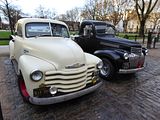
Also here was a recent Camaro SS.
CITROEN
Citroen created a higher-powered more sporting CX with the 128 bhp fuel injected GTi in 1977, but in 1984, a more potent true of the top of the range joined it, adopting the then very popular expedient of strapping a turbocharger to the 2500cc engine which upped the power to 168 bhp. A larger rear spoiler was fitted to aid high speed stability.
CROSSLEY
The car is a 1934 Crossley 2 Litre Sports saloon with coachwork by Ranalah of Kew. Few will have even heard of Crossley, though a long running Matchbox “Models of Yesteryear” model of an RAF Fire Tender would have brought the brand to the notice of some. A British company, based in Manchester, they produced approximately 19,000 high-quality cars from 1904 until 1938, 5,500 buses from 1926 until 1958 and 21,000 goods and military vehicles from 1914 to 1945. Crossley Brothers, originally manufacturers of textile machinery and rubber processing plant, began the licensed manufacture of the Otto internal combustion engine before 1880. The firm started car production in 1903, building around 650 vehicles in their first year. The company was originally created as a division of engine builders Crossley Brothers, but from 1910 became a stand-alone company. Although founded as a car maker, they were major suppliers of vehicles to British forces during the First World War, and in the 1920s moved into bus manufacture. With re-armament in the 1930s, car-making was run down, and stopped completely in 1936. During the Second World War output was again concentrated on military vehicles. Bus production resumed in 1945 but no more cars were made. The directors decided in the late 1940s that the company was too small to survive alone and agreed a take over by AEC. Production at the Crossley factories finally stopped in 1958. Production of the first cars was on a small scale but from 1909 when a new range was introduced it rapidly built up. In that year the 20 hp was introduced (later called the 20/25) and this was taken up by the British War Office and from 1913 it was ordered for the new Royal Flying Corps (RFC). The outbreak of the First World War resulted in a rapid expansion of the RFC, and by 1918 they had over 6,000 of the vehicles with staff car, tender (light truck), and ambulance bodies. Crossley 25/30 hp Tenders were used by the British Army in Ireland from 1919 until their withdrawal in 1922. The Irish Army continued to use them for troop transport throughout the Civil War period, but they were worked hard and appeared to have received little care: of 454 originally supplied, only 57 were in service by 1926 with a further 66 being overhauled or repaired. The 20/25 model was also the first vehicle to be supplied to London’s Metropolitan Police Flying Squad in 1920, some of which were fitted with radio equipment. Car production resumed after the First World War and a new model, the 19.6, was launched in 1921 and joined in 1922 by the smaller 2.4 litre 14 hp model that would become the company’s best seller. The 19.6 was replaced by the 2.7 litre 18/50 in 1925 fitted with Crossley’s first six-cylinder engine and this was enlarged in 1927 to 3.2 litres in the 20.9. Crossley were the first British car company to offer a factory fitted car radio in 1933. Although the large cars would continue to be available, a range of small models fitted with Coventry Climax engines was announced in 1931 but sales of the cars slowly declined and the last ones were made in 1937. The model seen here, the 2 litre Sports Saloon, was introduced in 1934, sporting an aluminium body, a new chassis and running gear and modified engine, with a Wilson pre-selector gearbox. “The Motor” magazine found it “speedy refined and comfortable” capable of 76mph with a 0-60 time of 25 seconds in 3rd gear. An overall mpg of 17.4 was recorded. At £695 it was expensive and only about 25 were made of which 4 survive, all different, though this is the only one currently on the road. Apart from the prototype, which was Crossley bodied, all the bodies were made by Ranalah.
DODGE
Perhaps the largest vehicle present this month, this Ram Pickup made three laps of the Square before parking up at an angle over three spaces. It’s just as well that the event was not as busy as it can sometimes get. This is an example of the first generation of Dodge to bear the Ram name. First seen in 1981, it was not really an all new design so much as a facelift of the fourth generation of the D Series, dating back to 1972. The name change was one of the alterations made when Lee Iacocca took charge of the ailing Chrysler Corporation. Ram as a name came about as this recalled the bonnet ornament first seen on a 1933 Dodge truck, and the new branding was pretty evident in the new design, with an embossed “DODGE RAM” name on the tailgate along with other obvious changes like the grille and bonnet, the taillights, and the entire interior. More subtle was the addition of a “shoulder” line reminiscent of the GM competition. Beginning in 1981, even more corrosion-resistant steel was used in the construction of the trucks. This body style continued until 1994 and many of these vehicles are still on the road. Many body panels are interchangeable for all models from 1972–1994, so it is not uncommon to see a “hybrid” with, as an example, a 1978 grille mounted with a 1974 bonnet and a 1991 cab. Sometimes the bed is swapped with a moving truck style box for models like these. In most jurisdictions, the year is dictated by the year of the truck’s chassis regardless of the body which has been bolted to it. Also kept was the Utiline step-side model that had the same truck bed that dated back to the 1940s. This was dropped during this last era of the W/D Dodge trucks. A narrower range of engines was offered: the base power plant was the 225 cu in (3.7 litre) slant-6, now with top-fed hydraulic tappets, and the 318 cu in (5.2 litre) and 360 cu in (5.9 litre) LA-series V8s. The slant-6 was supplanted by the 3.9 litre V6 for 1988; in 1992 it and the V8s became Magnum engines. The 6BT 5.9 litre 12-Valve Cummins B Series diesel engine became an option in 1989. Sales were good during the Sweptline era and into the late 1970s. A combination of stagnant styling nearly two decades old plus brand loyalty primarily to Chevrolet and Ford during the 1980s and 1990s reduced sales volume for the first generation Dodge Ram. A wholly new Dodge Ram was released for the 1994 model year.
FERRARI
A duo of Ferrari models once again, this month, with a 360 and F430 Spider parked up alongside each other.
FORD
There were rather fewer Fords here than usual. It is not uncommon to find a whole collection of sporting models all parked up together, but that was not the case here, though there were still a number of different models bearing the Blue oval badge.
Oldest of them was a Mark 2 Consul, a car which is seen here quite frequently. The Mark 2 range of Consul, Zephyr and Zodiac were launched in 1956, replacing the five year old first generation models. Zephyr and Zodiac models had six cylinder engines and were thought of as luxury cars, whereas the Consul, which in this guise had the Ford code of 204E, sharing the same basic bodyshell remained a four-cylinder sub-model of the Zephyr. Compared with the original, it had a longer wheelbase, a larger 1703 cc, 59 bhp engine and a complete restyle, borrowing cues from the 1956 models of America’s Thunderbird and Fairlane. One thing not updated was the windscreen wipers, which were still vacuum-operated. The roof profile was lowered in 1959 on the Mk2 version, which also had redesigned rear lights and much of the external bright work in stainless steel. Front disc brakes with vacuum servo appeared as an option in 1960 and were made standard in 1961. The name became the Consul 375 in mid-1961. It was a strong seller, with 371,585 examples made before the range was replaced the Zephyr 4 in 1962.
Sole sporting Escort present was this Mark 1. Sporting Escorts appeared only a matter of months after the launch of the regular 1100 and 1300cc cars. The first of these was a higher performance version designed for rallies and racing, the Escort Twin Cam. Built for Group 2 international rallying, it had an engine with a Lotus-made eight-valve twin camshaft head fitted to the 1.5 L non-crossflow block, which had a bigger bore than usual to give a capacity of 1,557 cc. This engine had originally been developed for the Lotus Elan. Production of the Twin Cam, which was originally produced at Halewood, was phased out as the Cosworth-engined RS1600 production began. The most famous edition of the Twin Cam was raced on behalf of Ford by Alan Mann Racing in the British Saloon Car Championship in 1968 and 1969, sporting a full Formula 2 Ford FVC 16-valve engine producing over 200 hp. The Escort, driven by Australian driver Frank Gardner went on to comfortably win the 1968 championship. The Mark I Escorts became successful as a rally car, and they eventually went on to become one of the most successful rally cars of all time with arguably the Escort’s greatest victory in the 1970 London to Mexico World Cup Rally, co-driven by Finnish legend Hannu Mikkola and Swedish co-driver Gunnar Palm. This gave rise to the Escort Mexico, which had a 1600cc “crossflow”-engined, as a special edition road version in honour of the rally car. Introduced in November 1970, 10,352 Mexico Mark I’s were built. In addition to the Mexico, the RS1600 was developed with a 1,601 cc Cosworth BDA which used a Crossflow block with a 16-valve Cosworth cylinder head, named for “Belt Drive A Series”. Both the Mexico and RS1600 were built at Ford’s Advanced Vehicle Operations (AVO) facility located at the Aveley Plant in South Essex. As well as higher performance engines and sports suspension, these models featured strengthened bodyshells utilising seam welding in places of spot welding, making them more suitable for competition. After updating the factory team cars with a larger 1701 cc Cosworth BDB engine in 1972 and then with fuel injected BDC, Ford also produced, in the autumn of 1973, an RS2000 model as an alternative to the somewhat temperamental RS1600, featuring a 2.0 litre Pinto OHC engine. This also clocked up some rally and racing victories; and pre-empted the hot hatch market as a desirable but affordable performance road car. Like the Mexico and RS1600, this car was produced at the Aveley plant. The car here bears RS badges and has a 2 litre engine under the bonnet, but was first registered in mid 1972, so it is not quite original, but still a nice example of the genre.
By the mid 1970s, Ford were offering the same cars in Britain as the rest of Europe, finally having rationalised the ranges and even the engines. This was an era when Ford’s marketing machine judged well just what the British buying public wanted, with a range of carefully stepped model trims applied to cars which featured up to the minute styling. Whilst the Escort, Cortina and then the Fiesta were the cars that generated most of the sales, the more costly models were the ones people aspired to, and there were two examples here. The Mark 2 Granada was launched in September 1977, in the same week as the Opel Rekord E, one of its principal rivals. Featuring new styling, this was a conventional car under the skin, and was the doyen of the executive car parks of the day.
The Capri was always something special, even if underneath it was “just” a Cortina. The third generation car, launched in March 1978 had the longest life, with production continuing through to the end of 1986. In 1981, the 3 litre Essex engine was replaced by the German designed 2.8 litre Cologne unit, and eventually a five speed gearbox was added. The car remained excellent value for money when you consider the performance it could deliver. This is a late model 2.8i.
More recent Fords, indeed from the current range, included a Fiesta ST and one of the latest mildly-facelifted third generation Focus ST cars.
Parked up with the Camaro was its arch rival, the Mustang, seen here in explosive GT500 guise. This car dates from around 2009.
Final Ford here was also an American model, a mildly customised 1937 V8 Coupe. After persisting with the same car, the Model T for almost 20 years, and its replacement, the Model A, for 5, Ford moved to annual model revisions from 1932. Sales volumes were strong, and with rationalisation of the number of manufacturers, it was Chevrolet who was the biggest rival. In 1936, Chevrolet outsold Ford, but that would change in 1937 with the latest models, the Models 73, 74 and 77 in 1937. These were available with a choice of a less potent 2.2 litre V8 as well as the 3.6 litre unit as well as new styling including a new V shaped grille and fared-in headlights. There were a vast number of different body styles available from the factory, with two and four door models, as well as open topped cars. The design would only last a year as further changes came on an annual basis every year for the rest of the live of this basic design, with the Models 81A and 82A in 1938, and Models 91A and 92A in 1939.. The 1938 recession hurt sales, as did Ford’s continuing of the 1937 cars, including most body panels. 1938 DeLuxe models were differentiated with a heart-shaped grille, though standard models retained the 1937 look.
HONDA
This was a nice example of the S2000, the much missed sports car that Honda produced to mark their 50th anniversary. The S2000 was first alluded to at the 1995 Tokyo Motor Show, with the Honda Sport Study Model (SSM) concept car, a rear-wheel-drive roadster powered by a 2.0 litre inline 4-cylinder engine and featuring a rigid ‘high X-bone frame’ which Honda claimed improved the vehicle’s rigidity and collision safety. The concept car was constructed with aluminium body panels and featured a 50:50 weight distribution. The SSM appeared at many automotive shows for several years afterwards, hinting at the possibility of a production version, which Honda finally announced in 1999. It featured a front mid-engine, rear-wheel-drive layout with power being delivered by a 1,997 cc inline 4-cylinder DOHC-VTEC engine. The engine produced outputs of 237–247 hp, and 153–161 lb/ft depending on the target market., and it was mated to a six-speed manual transmission and Torsen limited slip differential. The S2000 achieved what Honda claimed as “the world’s top level, high performance 4-cylinder naturally aspirated engine”. Features included independent double wishbone suspension, electrically assisted steering and integrated roll hoops. The compact and lightweight engine, mounted entirely behind the front axle, allowed the S2000 to achieve a 50:50 front/rear weight distribution and lower rotational inertia. An electrically powered vinyl top with internal cloth lining was standard, with an aluminium hardtop available as an optional extra. Although the S2000 changed little visually during its production run, there were some alterations, especially in 2004, at which point production of the S2000 moved to Suzuka. The facelifted car introduced 17 in wheels and Bridgestone RE-050 tyres along with a retuned suspension to reduce oversteer. The spring rates and shock absorber damping were altered and the suspension geometry modified to improve stability by reducing toe-in changes under cornering loads. The subframe has also received a revision in design to achieve a high rigidity. In the gearbox the brass synchronisers were replaced with carbon fibre. In addition, cosmetic changes were made to the exterior with new front and rear bumpers, revised headlight assemblies, new LED tail-lights, and oval-tipped exhausts. Although all the cosmetic, suspension and most drivetrain upgrades were included on the Japanese and European S2000s, they retained the 2.0 litre F20C engine and remained designated as an AP1. A number of special editions were made, such as the more track-oriented Club Racer version offered in the US in 2007/8 and the Type S for Japan in 2008/9. The UK received a GT for 2009, which featured a removable hard-top and an outside temperature gauge. The S2000 Ultimate Edition (continental Europe) and GT Edition 100 (UK) were limited versions of the S2000 released to commemorate the end of production. Both included Grand Prix White body colour, removable hard top, graphite-coloured alloy wheels, red leather interior with red colouring for stitching on the gear lever gaiter. The Ultimate Edition was unveiled at the 2009 Geneva Motor Show and went on sale in March 2009. The GT Edition 100 was a limited run of 100 units released for the UK market. In addition to the Ultimate Edition’s specification, it featured a black S2000 badge and a numbered plaque on the kick-plate indicating which vehicle in the series it was. The car was never replaced, as Honda decided to head off in the same direction as Toyota, producing a series of very dull appliance-like cars that focused on low emissions and dependability but of no appeal to the sort of enthusiast who bought (and probably kept!) an S2000.
JAGUAR
Perhaps the most valuable car here, and certainly one of the very nicest was this XK150S fixed head coupe. This particular car has just been restored and it looked absolutely amazing. Although bearing a family resemblance to the XK120 and XK140, the XK150, launched in the spring of 1957, was radically revised. A one-piece windscreen replaced the split screen, and the wing line no longer dropped so deeply at the doors. The widened bonnet opened down to the wings, and on the Roadster the windscreen frame was moved back 4 inches to make the bonnet longer. The XK140’s walnut dashboard was replaced by one trimmed in leather. On the early Drophead Coupés, the aluminium centre dash panel, which was discontinued after June 1958, had an X pattern engraving similar to the early 3.8 E-Type. Thinner doors gave more interior space. On the front parking lights, which were located atop the wings, a little red light reminded the driver the lights were on. Suspension and chassis were very similar to the XK140, and steering was by rack and pinion; power steering was not offered. The standard engine, the similar to the XK140, but with an new “B” type cylinder head, was the 3.4 litre DOHC Jaguar straight-6 rated at 180 SAE bhp at 5750 rpm but most cars were fitted with the SE engine whose modified cylinder head (B type) and larger exhaust valves boosted the power to 210 SAE bhp at 5500 rpm. Twin 1.75-inch (44 mm) SU HD6 carburettors were fitted. While the first XK150s were slower than their predecessors, the deficit was corrected in the spring of 1958 with a 3.4-litre “S” engine whose three 2-inch SU HD8 carburettors and straight-port cylinder head increased power to a claimed 250 SAE bhp. For 1960, the 3.4 litre engine was bored to 3.8 litres, rating this option at 220 hp in standard tune or 265 hp in “S” form. A 3.8 litre 150S could top 135 mph and go from 0–60 mph in around 7.0 seconds. Fuel economy was 18mpg. Four-wheel Dunlop 12 in disc brakes appeared for the first time although it was theoretically possible to order a car with drums. When leaving the factory the car originally fitted either 6.00 × 16 inch Dunlop Road Speed tyres as standard, or you could specify 185VR16 Pirelli Cinturato CA67 as a radial option on either 16 × 5K½ solid wheels (basic models) or 16 × 5K wire wheels. Production ended in October 1960, and totalled 2265 Roadsters, 4445 Fixed Head Coupés and 2672 Drophead Coupés. Only a handful of these 3.8 litre S models were made in right hand drive.
The XK150 was replaced by the E Type, which was first seen at the 1961 Geneva Show, in both open-topped Roadster and closed Coupe form. Needing no introduction, the E Type is one of the most popular classics there is, and this early-ish car was a splendid example. It has clearly been restored, with everything apart from the seats, which bore clear signs of use, looking pretty much as it would have done on leaving the factory. The car may have been brilliant, but it was not perfect. One little foible which the owner demonstrated was that on the Coupe, the rear hatch was hinged sideways and has a simple stay which is used to hold open in position, but the design of this is not strong enough and it is all too easy for the boot to close itself on an unsuspecting person reaching into the load area. I think I could live with that in exchange for a car that looks as good as this!
LAMBORGHINI
Although there had been some suggestions from an Aventador owner on the event’s Facebook page that he was contemplating attending, he was not in evidence, meaning that the Lamborghini marque was just represented by this Huracan. Sales of the entry level Lamborghini have been strong since its launch in the summer of 2014, so whilst it does not yet outnumber the Gallardo on our roads, it doubtless will get to that point. 2016 will see more model derivatives added to the range, which will broaden the appeal.
LANCIA
A real favourite for me, and plenty of others, was this Delta Integrale. The Integrale evolved over several years, starting off as the HF Turbo 4WD that was launched in April 1986, to homologate a new rally car for Lancia who needed something to fill the void left by the cancellation of Group B from the end of 1986. The Delta HF 4X4 had a four-wheel drive system with an in-built torque-splitting action. Three differentials were used. Drive to the front wheels was linked through a free-floating differential; drive to the rear wheels was transmitted via a 56/44 front/rear torque-splitting Ferguson viscous-coupling-controlled epicyclic central differential. At the rear wheels was a Torsen (torque sensing) rear differential. It divided the torque between the wheels according to the available grip, with a maximum lockup of 70%. The basic suspension layout of the Delta 4WD remained the same as in the rest of the two-wheel drive Delta range: MacPherson strut–type independent suspension with dual-rate dampers and helicoidal springs, with the struts and springs set slightly off-centre. The suspension mounting provided more isolation by incorporating flexible rubber links. Progressive rebound bumpers were adopted, while the damper rates, front and rear toe-in and the relative angle between springs and dampers were all altered. The steering was power-assisted rack and pinion. The car looked little different from the front wheel drive models. In September 1987, Lancia showed a more sophisticated version of the car, the Lancia Delta HF Integrale 8V. This version incorporated some of the features of the Delta HF 4WD into a road car. The engine was an 8-valve 2 litre fuel injected 4-cylinder, with balancing shafts. The HF version featured new valves, valve seats and water pump, larger water and oil radiators, more powerful cooling fan and bigger air cleaner. A larger capacity Garrett T3 turbocharger with improved air flow and bigger inter-cooler, revised settings for the electronic injection/ignition control unit and a knock sensor, boosting power output to 185 bhp at 5300 rpm and maximum torque of 224 lb/ft at 3500 rpm. The HF Integrale had permanent 4-wheel drive, a front transversely mounted engine and five-speed gearbox. An epicyclic centre differential normally split the torque 56 per cent to the front axle, 44 per cent to the rear. A Ferguson viscous coupling balanced the torque split between front and rear axles depending on road conditions and tyre grip. The Torsen rear differential further divided the torque delivered to each rear wheel according to grip available. A shorter final drive ratio (3.111 instead of 2.944 on the HF 4WD) matched the larger 6.5×15 wheels to give 24 mph/1000 rpm in fifth gear. Braking and suspension were uprated to 284 mm ventilated front discs, a larger brake master cylinder and servo, as well as revised front springs, dampers, and front struts. Next update was to change the engine from 8 valves to 16. The 16v Integrale was introduced at the 1989 Geneva Motorshow, and made a winning debut on the 1989 San Remo Rally. It featured a raised centre of the bonnet to accommodate the new 16 valve engine, as well as wider wheels and tyres and new identity badges front and rear. The torque split was changed to 47% front and 53% rear. The turbocharged 2-litre Lancia 16v engine now produced 200 bhp at 5500 rpm, for a maximum speed of 137 mph and 0–100 km/h in 5.5 seconds. Changes included larger injectors, a more responsive Garrett T3 turbocharger, a more efficient intercooler, and the ability to run on unleaded fuel without modification. The first Evoluzione cars were built at the end of 1991 and through 1992. These were to be the final homologation cars for the Lancia Rally Team; the Catalytic Evoluzione II was never rallied by the factory. The Evoluzione I had a wider track front and rear than earlier Deltas. The bodyside arches were extended and became more rounded. The wings were now made in a single pressing. The front strut top mounts were also raised, which necessitated a front strut brace. The new Integrale retained the four wheel drive layout. The engine was modified to produce 210 bhp at 5750 rpm. External changes included: new grilles in the front bumper to improve the air intake for engine compartment cooling; a redesigned bonnet with new lateral air slats to further assist underbonnet ventilation; an adjustable roof spoiler above the tailgate; new five-bolt wheels with the same design of the rally cars; and a new single exhaust pipe. Interior trim was now grey Alcantara on the Recaro seats, as fitted to the earlier 16V cars; leather and air conditioning were offered as options, as well as a leather-covered Momo steering wheel. Presented in June 1993, the second Evolution version of the Delta HF Integrale featured an updated version of the 2-litre 16-valve turbo engine to produce more power, as well as a three-way catalyst and Lambda probe. A Marelli integrated engine control system with an 8 MHz clock frequency which incorporates: timed sequential multipoint injection; self-adapting injection times; automatic idling control; engine protection strategies depending on the temperature of intaken air; Mapped ignition with two double outlet coils; Three-way catalyst and pre-catalyst with lambda probe (oxygen sensor) on the turbine outlet link; anti-evaporation system with air line for canister flushing optimised for the turbo engine; new Garrett turbocharger: water-cooled with boost-drive management i.e. boost controlled by feedback from the central control unit on the basis of revs/throttle angle; Knock control by engine block sensor and new signal handling software for spark park advance, fuel quantity injected, and turbocharging. The engine now developed 215 PS as against 210 PS on the earlier uncatalysed version and marginally more torque. The 1993 Integrale received a cosmetic and functional facelift that included. new 16″ light alloy rims with 205/45 ZR 16 tyres; body colour roof moulding to underline the connection between the roof and the Solar control windows; aluminium fuel cap and air-intake grilles on the front mudguards; red-painted cylinder head; new leather-covered three-spoke MOMO steering wheel; standard Recaro seats upholstered in beige Alcantara with diagonal stitching. In its latter years the Delta HF gave birth to a number of limited and numbered editions, differing mainly in colour, trim and equipment; some were put on general sale, while others were reserved to specific markets, clubs or selected customers.
LOTUS
Elise S2
MAZDA
As ever, there was an impressive assembly of MX5 models of all four generations, with the majority of the cars parked up together. I have to note that one of the owners decided to show off when leaving, sliding his car as he came off the Square, and although he did catch it, he very nearly collided with a line of parked cars. Such behaviour is totally indefensible in a location like this and if the gentleman concerned read this (or indeed if if any of his fellow MX5 Owners Club members see this and know the person who did this), perhaps it is timely to say that there are enough pressures on the event from parking attendants without additional problems of someone hooning on a public road where there are people and parked cars.
McLAREN
This distinctively painted 12C Spider is something of an event regular.
MERCEDES-BENZ
Three different generations of mid-sized Mercedes were here. Oldest was a W123 280E, the big selling Mercedes that was produced from 1976 to 1984, in Saloon, Coupe and Estate guises. These cars typefiy what the Germans call “Youngtimer” classics. Many of them are of course still in active service in Africa, where the car’s legendary reputation for toughness and almost indestructability makes them perfect. There are not that many of them left in the UK. the 280E was the top spec petrol model, and was identified by the use of a rectangular outer headlight beneath the glass cover.
The W201 was launched in 1982 as a smaller Mercedes, positioned under the W123 car. Initially sold with a choice of carburettor or injected 2 litre engines, the 190 and 190E brought Mercedes values and attributes to a slightly more affordable price point. It was not long before the range grew, first with a diesel, then the sporting 190E 2.3-16 with its Cosworth engine, before larger Mercedes units created the 190E 2.3 and 2.6. This car is effectively the C Class of its day, as indeed its replacement took on that name when Mercedes embarked on a renaming strategy.
Also present was one of the latest C Class models.
MG
Sole example of that evergreen classic, the MGB, was this MGB GT at this event.
MORRIS
I’ve not seen this beautifully presented J Van before. Its full name is the Morris Commercial J-type, and it is a 10 cwt (0.5 ton) van launched by Morris Commercial in 1949 and produced until 1961. After the formation of the British Motor Corporation in 1952, by the merger of Morris’ parent company, the Nuffield Organisation, and Austin, the Commercial name was dropped and the van was marketed as the Morris J-type. The van followed the emerging trend of having forward controls and sliding doors on each side. It was made in both left and right hand drive versions. As well as complete vehicles, the J-type was also supplied in chassis form to external body makers and it appeared, amongst other uses, as a pick-up, tipper truck, ice cream van and milk float. Many were bought by the British Post Office and these differed from standard in having rubber front and rear wings. The J type is fitted with a 1476 cc four-cylinder side-valve engine based on the one used in the contemporary Morris Oxford MO car. Drive to the rear wheels is through a three-speed gearbox and initially a spiral bevel type rear axle, later replaced by a hypoid type. The van was updated to the JB in 1957 when an overhead valve 1489 cc, BMC B-Series engine was fitted along with a four-speed gearbox. An Austin version of the van appeared in 1957 known as the Austin 101 and differed from the Morris only in badging and radiator grille styling. Production ceased early in 1961 after over 48,600 had been made. It was replaced by the Morris J4. Let’s hope it makes an appearance here, and preferably not parked up next to a skip!
Another popular classic is the Morris Minor, and there was a nice example of the Traveller here.
NISSAN
We in Europe know this model as a Bluebird, but confusingly, it was not, in the grand scheme of things, a replacement for the car that was sold before this model with Bluebird badges on it. This one was known outside Europe as the Auster, the name that became the Stanza, and before that the Violet, outside Japan. Confused? Yes, the Japanese produced vast ranges of cars in the 1970s and 1980s and only exported selected models. This car is significant as it is the first where the word “export” ceased to apply, as it was the first model to be produced in the huge Nissan Motors UK plant in Washington, Tyne and Wear. Known internally at Nissan as the T12 series, the car was introduced in Europe in early 1986 as a replacement for the short-lived U11 Bluebird. From July 1986, the T12 was assembled in the UK from parts shipped in from Japan, with saloon versions like this one available first and hatchback models following soon after. Confusingly, there was an Estate, but this was based on the U11 Series. These were also built in the UK. Although these 1.6, 1.8 and 2 litre engine cars were far from exciting, they proved so popular that in December 1987 Nissan announced the institution of a third shift, in order to bump production from 29,000 to circa 40,000 cars annually. During 1987, the T72 models replaced the T12, followed by a face lift around a year later. The face lift models had a more modern and European look, with round front and rear bumpers and the corporate slatted grille. These were eventually built entirely in the UK. In 1990, Nissan replaced the Bluebird with the Primera series. In the late 1980s and early 90s, Nissan Bluebirds were very commonly seen as taxis, their drivers racking up phenomenal mileage on just routine servicing. The bodyshell’s resistance to corrosion has become legendary – it is not uncommon to see Bluebirds as old as 1987 or 1988 vintage with virtually no trace of rust at all. However, the Bluebirds’ reliability and all-around robustness has ultimately led to its demise – as a banger racers’ car of choice – so there are not many left.
This was the final generation of the car sometimes known as the Silvia, but sold in Britain as the 240SX which sat under the Skyline in the Japanese marque’s extensive range. Released in the spring of 1994 as a 1995 model, the hatchback and convertible body styles of its S13 generation predecessor were eliminated, leaving only the coupe. The wheelbase car grew 2 in and the track width was also increased, while the overall length of the vehicle was slightly shorter than the previous generation. The curb weight of the vehicle increased by about 80 lb relative to the previous model. Dual air bags were added and the automatic seatbelts were replaced with common manual type. The pop-up headlights were removed in favour of fixed lamps. Though the general layout remained the same, almost all parts were redesigned to the extent that very few parts are interchangeable. The chassis was changed slightly to increase stiffness (Nissan claimed 50% torsional, 100% bending rigidity increase)and utilised higher rear strut mounts. The fuel tank, previously located at the rear end under the trunk floor, now sat in front of the rear suspension and behind the rear seats. The base model had 4-lug, 15-inch wheels, a softer suspension, and no rear anti-roll bar. The base model had several options and features available to be fitted to the car such as leather seats, ABS, and a viscous limited-slip differential. SE and LE models came equipped with 5-lug, 16-inch alloy wheels, a stiffer suspension than the base model, and a rear anti-roll bar. The LE was basically an upgraded SE model, but with more standard equipment such as leather seats, keyless entry, an antitheft system, and a CD player. Antilock brakes and a viscous limited-slip differential could be had as an optional package to both base and SE/LE models. In 1997, the 240SX received minor updates. The different looks of the S-Chassis are referred to as before change “Zenki” and after change “Kouki”. Changes were mostly aesthetic, including new projector headlights, front bumper, bonnet and wings, and revised taillights and centre panel. Side skirts became standard on the SE and LE trim level. 1998 marked the end of production for the Nissan 240SX. This generation of the 240SX suffered in sales due to the competition from other car manufacturers and consumers at the time choosing more practical vehicles, such as a SUV. Every 240SX was built in Kyūshū, Japan. The last 240SX rolled off the assembly line on July 23, 1998.
PEUGEOT
Launched in 1986, Peugeot 205 Convertibles were built alongside the Ferrari Testarossa, with Pininfarina having total control over the design of this model. Cars were part assembled with the unique cabriolet parts in Italy before shipping back to France for final production . With the exception of the bonnet and front wings all other panels were unique to the cabriolet. The total number of RHD convertibles sold in the UK was 6,223 in a production run from 1986-1994. This included both the 205 CTi and 205CJ versions. The CTi was first to market, being an open topped version of the established GTi. The CJ model was added to the range, as a cheaper model, based on the regular 1400cc XS car, in 1988 at a price of £8835! The final models of both types were supplied in 1993. The Roland Garros, as seen here, was the only limited model made available in the cabriolet range and was restricted to only 150 right hand drive cars sold in 1990-1991. Based on the 1400cc model, with a heady 85bhp from its twin carb all alloy engine, it proved quite spritely, as the car weighed so little! When new, the Roland Garros was the most expensive 205 cabriolet version, costing over £12980. The Roland-Garros was marketed as the range-topping model of the 205 lineup, and took its name following Peugeot taking on the sponsorship of the Roland Garros tennis tournament in 1989. Both body styles were offered exclusively in a model-specific shade of dark green and sat on bespoke 13-inch alloy wheels. They were instantly recognisable from other members of the 205 lineup thanks to Roland-Garros stickers on the wings and an emblem on the right side of the boot lid. The convertible came with a white soft top, which provided an elegant contrast with the green paint, while the hatchback was fitted with a large sliding moonroof. The front passengers were treated to bucket seats upholstered in white leather with grey, red and green inserts. Both cars came standard with tinted windows, power front windows and a cassette player, equipment that created an upmarket ambiance rarely found in the 205’s segment and helped justify their relatively high price. The finishing touch inside the car was a Roland-Garros emblem on the three-spoke steering wheel. There are few survivors.
PORSCHE
Arriving early in the morning was this brand new 911 GT3 RS. It belongs to the same gent who had brought along his Jaguar F Type Project Seven in December and at the time he had said that he was poised to take delivery of this car. And here it was, looking splendid, and stopping almost everyone in their tracks as they came along to admire it. Needing little in the way of introduction to enthusiasts, the RS version of the 991 GT3 was launched at the 2015 Geneva Motor Show in 2015, and featured in first drive articles in the press a few weeks later, with cars reaching the UK in the summer and another series of universally positive articles duly appearing. It had very big shoes to fill, as the 997 GT3 RS model was rated by everyone lucky enough to get behind the wheel, where the combination of extra power and reduced weight made it even better to drive than the standard non-RS version of the car. A slightly different approach was taken here, with the result weighing just 10kg less than the GT3. It is based on the extra wide body of the 991 Turbo. Compared to the 991 GT3, the front wings are now equipped with louvres above the wheels and the rear wings now include Turbo-like intakes, rather than an intake below the rear wing. The roof is made from magnesium a bonnet, whilst the front wings, rear deck and rear spoiler all in carbonfibre-reinforced plastic (CFRP), the rear apron is in a new polyurethane-carbonfibre polymer and polycarbonate glazing is used for the side and rear windows. The wider body allows the RS’s axle tracks to grow, to the point where the rear track is some 72mm wider than that of a standard 3.4-litre Carrera and the tyres are the widest yet to be fitted to a road-going 911. A long-throw crankshaft made of extra-pure tempered steel delivers the 4mm of added piston stroke necessary to take the GT3’s 3.8-litre flat six out to 3996cc . The engine also uses a new induction system, breathing through the lateral air intakes of the Turbo’s body rather than through the rear deck cover like every other 911. This gives more ram-air effect for the engine and makes more power available at high speeds. It results in an output of 500 bhp and 339 lb/ft of torque. A titanium exhaust also saves weight. The suspension has been updated and retuned, with more rigid ball-jointed mountings and helper springs fitted at the rear, while Porsche’s optional carbon-ceramic brakes get a new outer friction layer. Which is to say nothing of the RS’s biggest advancement over any other 911: downforce. The rear wing makes up to 220kg of it, while the front spoiler and body profile generates up to 110kg. In both respects, that’s double the downforce of the old 997 GT3 RS 4.0. The transmission is PDK only. The result is a 0-62 mph time of just 3.3 seconds, some 0.6 seconds quicker than the 997 GT3 RS 4.0 and 0-124 mph (0-200kmh) in 10.9 seconds. The 991 GT3 RS also comes with functions such as declutching by “paddle neutral” — comparable to pressing the clutch with a conventional manual gearbox –- and Pit Speed limiter button. As with the 991 GT3, there is rear-axle steering and Porsche Torque Vectoring Plus with fully variable rear axle differential lock. The Nürburgring Nordschleife time is 7 minutes and 20 seconds. The interior includes full bucket seats (based on the carbon seats of the 918 Spyder), carbon-fibre inserts, lightweight door handles and the Club Sport Package as standard (a bolted-on roll cage behind the front seats, preparation for a battery master switch, and a six-point safety harness for the driver and fire extinguisher with mounting bracket). Needless to say, the car was an instant sell out, even at a starting price of £131,296.
There were a couple of older 911s here, as well, showing the previous generations: a standard 997 Carrera is still a good looking car, and it was joined by an earlier 996 model.
Oldest of the 911 models present was this 993 based model which bore the name GT on its rear engine cover. That rung no bells with me, as I did not recall such a model being offered by Porsche. However. a little work online elicited the fact that the name was indeed used. Until 1997, the street version of the GT2 race car was named GT. It had almost the same engine as the Turbo, but operated with higher boost pressure and delivering 430 bhp, raised to 450 bhp for 1998, when a twin ignition was added. Porsche had a long history in racing their 911 model, which had got serious with the 911 Turbo Carrera entered in Group 5 in 1974, and then going through the 934 and 935 of the late 1970s, to the 959-based 961 and 964 RSR of the 80s. The GT2 came about as the racing version of the 993 Turbo. By the mid 1990s most of the sanctioning bodies of road racing had placed severe limitations if not outright bans on the use all-wheel drive systems, due in part to Audi’s earlier success in campaigning their various Quattro cars in touring car races around the globe, to Porsche’s 959 and its racing version the Porsche 961, and in part to the Nissan Skyline. It was in this atmosphere that in order to take their turbo-engined 993 racing, Porsche created the rear drive GT2. The deletion of the front drivetrain also brought with it the benefit of significant weight savings to the competition car. To qualify the car for racing a limited number of street GT2s were created for homologation purposes, which are now highly prized and valued by Porsche 993 collectors. The interior treatment of the GT2 is similar to that of the sibling Carrera RS. On the exterior, the bumpers of the Turbo have been cut back and replaced with bolt-on plastic pieces in order to accommodate large racing tyres and to help ease the repairs of damage that are an often reoccurring event in auto racing.
Very splendid indeed was this 356 1600 Super. The 356 was created by Ferdinand “Ferry” Porsche (son of Dr. Ing. Ferdinand Porsche, founder of the German company), who founded the Austrian company with his sister, Louise. Like its cousin, the Volkswagen Beetle (which Ferdinand Porsche Senior had designed), the 356 was a four-cylinder, air-cooled, rear-engine, rear-wheel-drive car utilising unitised pan and body construction. The chassis was a completely new design as was the 356’s body which was designed by Porsche employee Erwin Komenda, while certain mechanical components including the engine case and some suspension components were based on and initially sourced from Volkswagen. Ferry Porsche described the thinking behind the development of the 356 in an interview with the editor of Panorama, the PCA magazine, in September 1972. “….I had always driven very speedy cars. I had an Alfa Romeo, also a BMW and others. ….By the end of the war I had a Volkswagen Cabriolet with a supercharged engine and that was the basic idea. I saw that if you had enough power in a small car it is nicer to drive than if you have a big car which is also overpowered. And it is more fun. On this basic idea we started the first Porsche prototype. To make the car lighter, to have an engine with more horsepower…that was the first two seater that we built in Carinthia (Gmünd)”. The first 356 was road certified in Austria on June 8, 1948, and was entered in a race in Innsbruck where it won its class. Porsche re-engineered and refined the car with a focus on performance. Fewer and fewer parts were shared between Volkswagen and Porsche as the ’50’s progressed. The early 356 automobile bodies produced at Gmünd were handcrafted in aluminium, but when production moved to Zuffenhausen, Germany in 1950, models produced there were steel-bodied. Looking back, the aluminium bodied cars from that very small company are what we now would refer to as prototypes. Porsche contracted with Reutter to build the steel bodies and eventually bought the Reutter company in 1963. The Reutter company retained the seat manufacturing part of the business and changed its name to Recaro. Little noticed at its inception, mostly by a small number of auto racing enthusiasts, the first 356s sold primarily in Austria and Germany. It took Porsche two years, starting with the first prototype in 1948, to manufacture the first 50 automobiles. By the early 1950s the 356 had gained some renown among enthusiasts on both sides of the Atlantic for its aerodynamics, handling, and excellent build quality. The class win at Le Mans in 1951 was clearly a factor. It was always common for owners to race the car as well as drive them on the streets. They introduced the four-cam racing “Carrera” engine, a totally new design and unique to Porsche sports cars, in late 1954. Increasing success with its racing and road cars brought Porsche orders for over 10,000 units in 1964, and by the time 356 production ended in 1965 approximately 76,000 had been produced. The 356 was built in four distinct series, the original (“pre-A”), followed by the 356 A, 356 B, and then finally the 356 C. To distinguish among the major revisions of the model, 356’s are generally classified into a few major groups. 356 coupés and “cabriolets” (soft-top) built through 1955 are readily identifiable by their split (1948 to 1952) or bent (centre-creased, 1953 to 1955) windscreens. In late 1955 the 356 A appeared, with a curved windshield. The A was the first road going Porsche to offer the Carrera 4 cam engine as an option. In late 1959 the T5 356 B appeared; followed by the redesigned T6 series 356 B in 1962. The final version was the 356 C, little changed from the late T6 B cars but with disc brakes to replace the drums. This car dates from 1959, but is still an A model.
There was also an example of the second generation Boxster here.
RENAULT
Renault made over 8 million R4 models between 1961 and the end of production in 1992, and the car was very popular in the UK throughout the 70s, but when did you last see one? There are some left, but not many, as rust has claimed almost all those 8 million, even in its native France. And that’s where this one has come from, still sporting French licence plates. It is a late model car, by which time the 1108cc engine was standard, and the handbrake had been moved to the floor, though it still had the toffee apple on a stick style gear lever sprouting from the middle of the dash.
A couple of examples of the second generation Megane, the one with the unusual rear end styling, caught my eye. More obvious of the two was a RenaultSport RS 230 Renault F1 team R26 to give the car its full name, in the iconic colour of Liquid Yellow, and elsewhere was a 5 door Megane Renault Sport dCi 175, a version with a 1995 cc diesel engine rated at 173 PS (171 bhp) at 3750 rpm and 270 lb·ft at 2000 rpm. this version was available with the Cup Chassis option, 18-inch anthracite alloy wheels with 225/45R18 Continental SportContact 2 tyres, retuned dampers and spring rates, disconnectable ESP and anthracite coloured door mirror housings. It came with a choice of 5 or 3 doors.
TOYOTA
This is a fifth generation Celica, the sporty Coupe that Toyota produced initially as a rival to the Ford Capri, back in 1970. It went on to live some years longer than the Ford, and thanks to a policy of all Japanese makers at the time of renewing their cars every 4 years, was available in far more distinct generations than its European rivals. The fifth generation car was produced form 1989 to 1993. Compared to its predecessor, it had new Super Round organic styling, upgraded wheels and tyres, more powerful GT-Four (US: All-Trac Turbo) with better cooling system, and for the Japanese market only, the 4-Wheel Steering (4WS) models. Toyota engineers claimed that the round styling and lack of straight edges increased strength without adding weight. The styling was later copied by other manufacturers. There were all manner of different versions offered in the Celica’s major markets and whilst the styling was perhaps more transatlantic in appeal than had been the case with the fourth generation car, it was adapted for Europe, where versions included a 1.6 ST-i (not sold in the UK), the 2.0 GT-i 16, and GT-Four. Some markets got a two door version., but it was the three door hatch which found its way to the UK, and the 2.0 GT-i 16 cabriolet was offered only in certain European countries. Only the 2.0 GT-i 16 liftback and GT-Four were officially sold in the UK.
It was interesting to see this LandCruiser, an example of Toyota’s longest running model series. Production of the first generation Land Cruiser began in 1951, as Toyota’s version of a Jeep-like vehicle, and since then, the Land Cruiser has been produced in convertible, hardtop, station wagon, and utility truck versions. The Land Cruiser’s reliability and longevity has led to huge popularity, especially in Australia where it is the best-selling body-on-frame, four-wheel drive vehicle. As of 2014, the Land Cruiser J200 is available in every market except Canada (where the Lexus LX is available), North Korea, and South Korea. The version seen here is a J40, the model designation for a Toyota Land Cruiser 40 series made from 1960 until 1984. Most of the J40s built had bodies like this one, a 2-door SUVs with slightly larger dimensions than a Jeep CJ, but it was also available with a choice of short, medium or long wheelbase, an estate like model and a pick up. A number of petrol and diesel engines were offered. There were updates to the mechanical specification during its long production life, but the body styling changed little.
TRIUMPH
I noticed that the owner of this Sptifire Mark 3 managed to make it back to his car to put the roof up as soon as it started raining, which would have saved him from having to sit on a wet seat when he headed for home. Many will tell you that they think the Mark III, introduced in March 1967, and the first major facelift to the Spitfire, was the best looking of the different versions of Triumph’s popular small sports car. For this version, the front bumper was raised in response to new crash regulations, as well as the front coil springs being slightly raised, so although much of the bonnet pressing was carried over, the front end looked quite different. The rear lost the overriders from the bumper but gained reversing lights as standard (initially as two separate lights on either side of the number plate, latterly as a single light in a new unit above the number plate); the interior was improved again with a wood-veneer instrument surround and a smaller 15 inch wire spoked steering wheel. A folding hood replaced the earlier “build it yourself” arrangement. For most of the Mark III range, the instrument cluster was still centre-mounted (as in the Mark I and Mark II) so as to reduce parts bin counts (and thereby production costs) for right-hand and left-hand drive versions. The 1147 cc engine was replaced with a bored-out 1296 cc unit as fitted on the new Triumph Herald 13/60 and Triumph 1300 saloons. A new quieter exhaust gave a sweet distinct note and reduced cabin noise. In SU twin-carburettor form, the engine put out a claimed 75 bhp at 6000 rpm, and 75 lb·ft of torque at 4000 rpm, and made the Mark III a comparatively quick car by the standards of the day. Popular options continued to include wire wheels, a hard top and a Laycock de Normanville overdrive, and far more relaxed and economical cruising at high speeds. The Mark III was the fastest Spitfire yet, achieving 60 mph in 13.4 seconds,and reaching a top speed of 95 mph. Average fuel consumption was improved slightly at 33mpg. The Mark III actually continued production into 1971, well after the Mark IV was introduced. On 8 February 1968, Standard-Triumph General Manager George Turnbull personally drove the 100,000th Triumph Spitfire off the end of the Canley production line. More than 75 per cent of the total production had been exported outside the UK, including 45 per cent to the USA and 25 per cent to mainland European markets.
Also present here was an example of the Stag.
TVR
There were a couple of TVR models here. Older of the duo was a 350i. One of the “wedge” era TVRs produced from 1980, this was the car which finally brought the Tasmin series to life. During the 1970s, TVR was making the M Series, including the Taimar hatch and open topped 3000S, which had their roots way back in the 60s, and Martin Lilley was looking for where to take the Blackpool based company next. He noted that Lotus appeared to have reinvented itself with the Elite, Eclat and Esprit, losing much of the kit-car image in the process, and he thought he needed to do something similar. He needed a new design language, so he contacted Oliver Winterbottom who had done the Elite/Eclat for the Norfolk firm, hoping for something new. The wedge-shaped design that Winterbottom created was designed in 1977, and a prototype was created the following year, before the car’s launch very early in 1980. Based on the Taimar, but with new wedge styling, the car was not exactly received with massive enthusiasm. The styling looked a bit like yesterday’s car, as the wedge era was on the wane, and the car’s price pitched it against cars like the Porsche 924 Turbo. Development of the new car had drained TVR’s finances, which led to Lilley ceding control of the company in 1981 to Peter Wheeler. The convertible that followed helped matters a bit, whereas the 2 litre 200 and the 2+2 model did not, but in 1983, TVR announced a revised version with the potent Rover 3.5 litre V8 under the bonnet, in lieu of the 2.8 litre Ford Essex unit, and it transformed the car. It was just the transformation the car needed, and over the next few years, a series of ever more potent models, with ever wilder styling came into the range. By 1986, the 450SEAC boasted 340 bhp, making this something of a supercar.
TVR “Wedges” have their own following these days, though they are far less common than the models which followed over the next 20 years, definitely the glory era of the TVR company. The Tuscan, the other car to be seen here, was launched in 2000, by which time there had been a series of what we think of as the modern era TVRs produced for nearly a decade, the Cerbera, Griffith and Cerbera. The Tuscan did not replace any of them, but was intended to help with the company’s ambitious push further up market to become a sort of Blackpool-built alternative to Ferrari. It did not lack the styling for the task, and unlike the preceding models with their Rover V8 engines, the new car came with TVR’s own engine, a straight six unit of 3.6 litre capacity putting out 360 bhp. The Tuscan was intended to be the grand tourer of the range, perfectly practical for everyday use, though with only two seats, no ABS, no airbags and no traction control, it was a tough sell on wet days in a more safety conscious world, but at least there was a removable targa top roof panel for those days when the sun came out. The car may have lacked the rumble of a V8, but when pushed hard, the sound track from the engine was still pretty special, and the car was faster than the Cerbera, but sadly, the car proved less than reliable, which really started to harm TVR’s reputation, something which would ultimately prove to be its undoing. That’s a shame, as looking at it parked up here, this really does appear as special as the Ferrari models parked elsewhere on the Square.
VAUXHALL
Getting rare now is the Calibra, a model that GM introduced to counter the Japanese sports coupés of the late 1980s and early 1990s. Launched in 1989, it employed the running gear of the first generation Opel Vectra, which had been launched a year earlier in 1988. Calibra production was based in the Opel factory in Rüsselsheim, Germany, and the Valmet Automotive factory in Uusikaupunki, Finland, where production was consolidated in November 1995. Known in Europe as the Opel Calibra and as a Vauxhall in the UK, it was also marketed as the Chevrolet Calibra in South America and the Holden Calibra in Australia and New Zealand. The Calibra was styled by GM’s designer Wayne Cherry and the German designer, Erhard Schnell. and when launched, it was the most aerodynamic production car in the world, with a drag coefficient (Cd) of 0.26. It remained the most aerodynamic mass production car for the next 10 years, until the Honda Insight, along with the Audi A2, were launched both in 1999, with a Cd of 0.25, though the more powerful 16V, V6, 4×4 and turbo models had a worse Cd of 0.29, due to changes in their cooling system, underbody, use of spoked wheels and glass detail. As a front-wheel drive coupé based on the Vectra A chassis, its ride and handling were not significantly better than that of the large family car from which it grew. Though it had a stiffer chassis as a whole (better torsional rigidity in NM/Deg). The 4WD turbo version of the car, which had independent rear suspension, featured the rear axle of the Opel Omega A with some minor alterations to it. Power was initially from 2.0 litre 8-valve 115 bhp and a Cosworth designed 16-valve fuel-injected 150 bhp four-cylinder redtop petrol engines. In 1992 a turbocharged 2.0 litre 16 valve 204 bhp engine was added to the range. With four-wheel drive, a six-speed Getrag manual transmission and a claimed top speed of 152 mph, this flagship model finally gave the Calibra the dynamics to match its looks. The Turbo model was also notable for the 5-stud wheel hubs and the extreme negative camber of its rear wheels, which is apparent even from a cursory visual inspection. In 1993 a 167 hp 2.5 litre V6 (was introduced. Available with both manual and automatic transmissions, the V6 was not as fast as the Turbo, but was rather more civilised, and proved to be more reliable as car than the complex four-wheel drive model. 1995 saw the introduction of the X20XEV Ecotec engine, a new version of the classic C20XE 16-valve or “red top” engine. This marked a reduction in power from 150 bhp to 136 bhp for the 16-valve version, although the Turbo continued with the older C20LET. Throughout the production run, several special edition models were launched. This began with the 1993 SE1, and ran through to the SE9 in 1997. These limited run editions had often unique aspects. For example, solar yellow paint on the SE2, or “Icelandic” blue on the SE6. Neither colours were found on any other Calibra. In September 1995, the Vectra A was replaced, but Calibra production continued until 1997. During its lifetime, the Calibra was much more popular in Europe, and outsold its nearest rival, the Ford Probe, which was considered to be underpowered, and very American for most European drivers, but in the UK, it failed to outsell the Rover 200 Coupé, which offered comparable performance, but without 4WD in the top–of–the–range models.
There was another appearance for this Cavalier SRi Hatch that I first saw at the November 2015 meet. In its day, the third generation Cavalier was a top selling car, and they appeared to be everywhere. Although the cheaper L and GL models achieved a lot of the sales, the SRi models were popular, as well, but there are fewer than 100 left now. I did not get the chance to talk to the owner this time, but I did in November when he said that he had found this one a few months ago, and learning that it had the typical sort of limited use for most of the last 20 years, with just 58,000 miles beneath its wheels, as an inveterate Cavalier enthusiast, who has had over 10 different examples over the years, he just had to have it. There were a few rust issues to sort out, but it sailed through the MOT test and it starred here as a reminder of what we all drove, or aspired to drive before we became obsessed with premium badges.
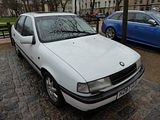
VOLKSWAGEN
There were a pair of customised Beetles parked up on one corner of the Square. Not particularly to my taste, but there are plenty of people for whom these would have huge appeal, so good to see them here.
Proof that although looking at the weather forecast is a good clue of what to expect, there is no substitute for checking what is actually happening outside, and then throwing caution to the wind and setting off for an event like this is not a bad strategy as this proved to be a very enjoyable event. There was more than enough of interest to keep me interested for more than 2 hours, by which time the rain did arrive. Looking at the diary, it’s going to be a couple of months before I am likely to be able to attend this event again, by which time let’s hope that the weather is decidedly less grey and more spring like. The next meeting here will be on 14th February.



